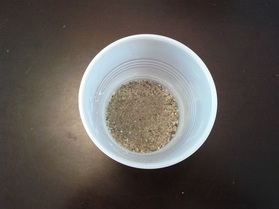What are Sedimentary rocks?
Instant Sandstone!

Sand+ Epsom salts solution
Materials
Regular sand
Epsom salts
Plastic cup
Materials from your house
Warm Water
Cup
1/4 cup measure
1/2 cup measure
Paper towel
How do I begin?
1. First, prepare your Epsom salts solutions. Take 1/4 cup measure of Epsom Salts and put it the cup you got from home.
2. Add 1/2 cup measure of warm water. Mix well so that most of the Epsom Salts are dissolved.
3. Now add the sand to the plastic cup provided by TndrBOX.
4. Pour the Epsom salts solution to the sand, so that the sand is completely covered. If there is excess solution, pour it out.
5. Leave the cup in an undisturbed, warm place for about two days to let the mixture set. Keep checking on it at regular intervals to ensure it is drying well.
6. After about two days, or more (depending on how dry the sand is), upturn the plastic cup, gently tap the back of the cup to get the mixture out. It may be a little wet, but should be dry enough to hold the shape of the plastic cup.
Place it on a paper towel and keep it there for another two days.
7. Great job! You made your own Sandstone in days!
What just happened?
Sandstone is one type of a Sedimentary rock. Sedimentary rocks take years and years to form; you made yours in record time!
Sedimentary rocks are formed by sediment or pieces that is deposited over time, usually as layers at the bottom of lakes and oceans. This sediment is compressed over a long period of time and consolidates into solid layers of rock.
These layers are called strata. Sedimentary rocks cover the majority of the Earth's rocky surface (about 75%) but only make up a small percentage of the Earth’s crust compared to metamorphic and igneous types of rocks.
Regular sand
Epsom salts
Plastic cup
Materials from your house
Warm Water
Cup
1/4 cup measure
1/2 cup measure
Paper towel
How do I begin?
1. First, prepare your Epsom salts solutions. Take 1/4 cup measure of Epsom Salts and put it the cup you got from home.
2. Add 1/2 cup measure of warm water. Mix well so that most of the Epsom Salts are dissolved.
3. Now add the sand to the plastic cup provided by TndrBOX.
4. Pour the Epsom salts solution to the sand, so that the sand is completely covered. If there is excess solution, pour it out.
5. Leave the cup in an undisturbed, warm place for about two days to let the mixture set. Keep checking on it at regular intervals to ensure it is drying well.
6. After about two days, or more (depending on how dry the sand is), upturn the plastic cup, gently tap the back of the cup to get the mixture out. It may be a little wet, but should be dry enough to hold the shape of the plastic cup.
Place it on a paper towel and keep it there for another two days.
7. Great job! You made your own Sandstone in days!
What just happened?
Sandstone is one type of a Sedimentary rock. Sedimentary rocks take years and years to form; you made yours in record time!
Sedimentary rocks are formed by sediment or pieces that is deposited over time, usually as layers at the bottom of lakes and oceans. This sediment is compressed over a long period of time and consolidates into solid layers of rock.
These layers are called strata. Sedimentary rocks cover the majority of the Earth's rocky surface (about 75%) but only make up a small percentage of the Earth’s crust compared to metamorphic and igneous types of rocks.

